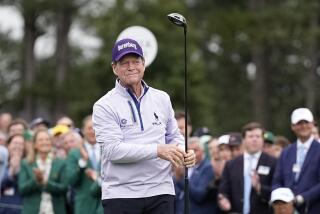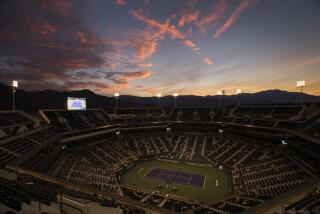NET RESULT : In Men’s Tennis, Players Gain Control, but Schedule Is Now in Doubt
- Share via
NEW YORK — The most important tennis game in town during the long weekend of the recent Nabisco Masters tournament wasn’t the one being played on the court inside Madison Square Garden. It was the one going on at the lectern of the press room, the one being discussed in hotel conference rooms, the one that has turned young, sometimes immature tennis players into serious spokesmen for their cause.
Fed up with the way their game is being run, the Association of Tennis Professionals has decided to break away from the Men’s Tennis Council, which organizes the men’s tour, and form its own circuit in 1990. The MTC just last week announced its own new tour in a faint hope that it’s not too late to get the players back. This doesn’t mean there will be two tours, because negotiations are likely to continue, but it does mean the politics of men’s tennis will be more confusing than ever. At least some tournament directors and sponsors are caught in the middle, waiting to see which way the wind blows next.
“Basically, they are fighting over control of the game,” said Donald Dell, chairman of ProServ Inc., and a supporter of the players. “You can talk about circuits and dates and money, but what both sides really are saying is they want to control the game.”
This has been a common theme in professional sports in the 1980s, players wanting more control -- and more money -- as sponsorship and interest in pro sports has grown. Last year, Hamilton Jordan, Jimmy Carter’s White House chief of staff, became the ATP’s chief executive officer. He said he wanted men’s tennis to be run more like men’s golf, where the PGA controls the game, although he admitted to concerns about the impetuous nature of the world’s far-flung tennis stars.
As he made plans for the new tour, Jordan said he was “shocked” to discover the level of commitment by the top pros: 22 of the top 25 players (and 85 of the top 100) have signed contracts to play on the ATP tour. He said he was equally surprised and pleased to see seven of eight players here for the Masters come out for an ATP news conference last week. Top-ranked Mats Wilander, Boris Becker, Andre Agassi and Tim Mayotte were among those who showed up; only Ivan Lendl did not, and he refused to discuss his opinions on the subject. (Lendl, Jimmy Connors and Andrei Chesnokov are the three top players unsigned by the ATP.)
“The players are showing me they will do the little things to get this going,” Jordan said. “Everyone said they wouldn’t stick with it. Well, they’ve shocked me.”
Under Jordan’s activist leadership, the players have staged a revolt, demanded more of a voice in their tour -- and seceded to start their own tour, all in the past few months. They have forced the MTC’s hand, and now that the MTC has responded with changes, they say it’s too late, that they are going ahead with their tour.
In this off-the-court battle over men’s tennis, the players have increased their say in their game. Under the present system, the ATP, the tournament directors and the International Tennis Federation, which runs the Grand Slam events, each have a 33 percent voice in how men’s tennis is governed. In a new ATP tour, the players and tournament directors will share control 50-50, with a CEO, elected by that governing panel, present to break ties.
The players also have announced the skeleton of their 1990 tour, which will be scheduled around Wimbledon, the Australian, French and U.S. Opens and Davis Cup play and will allow for an eight-week offseason. Under the current system, players complain they have no offseason and say that because they are either tired or injured, they don’t play as well as they should near year’s end. (Of course, they also play numerous lucrative exhibitions, but they don’t complain about that.)
Their new tour proposal calls for the season-ending ATP finals to be held the week of Nov. 12. There also will be an open week before and after each Grand Slam and Davis Cup event.
Late next month, an ATP committee will pick eight tournaments in North America, nine in Europe and two in Asia as premier events that each will showcase five or six of the top 10 players. The top players must play 10 of these 19 tournaments, plus the four Grand Slam events. Thirteen will be $1 million “World Series” tournaments and six will offer $500,000 in prize money.
The schedule is “streamlined,” the ATP says, cutting about 11 top-flight tournaments from the circuit, but adding more lower-level events, which could include the 11 that lose the top status. The players say this will increase competitiveness and rivalries by having more top players at the same tournaments and will unclutter a calendar that schedules tournaments in Milan and Memphis the same week. No one says it, but they would like to be more like the women’s tour, which has been a model of stability, has cultivated its rivalries and enjoys the leadership of its top players.
When the 1989 circuit is completed, the players’ plan says they will take over, leaving the MTC out of the business of running men’s tennis.
Game, set and match, right? Not so fast.
Marshall Happer, MTC administrator, agrees that something must be done about the confusion of scheduling in men’s tennis, and agrees that the players deserve more control of their sport.
“We are refocusing professional tennis so there is something really big other than the Grand Slam tournaments,” he said. “A lot of people say tennis is so confusing, they just watch the Grand Slams.”
So, last week, the former Raleigh, N.C., attorney called his own news conference to give the players something to think about: a new MTC tour.
Top players would be given signing bonuses based on their rankings, payable after they fulfilled their commitment to play in 12 tournaments a year. The top player in the world could earn $1.2 million in addition to prize money he wins.
The 12 major tournaments would include the four Grand Slam events, plus eight others from among a choice of 14 $1 million “World Series” tournaments and 13 “Super Series” events.
Happer also gave the players a 50 percent voting block in governing the council, just like the plan in the ATP tour.
Perhaps more important, Happer is trying to woo the players back by talking about sponsorship -- or lack thereof. His tour has more tournaments but still lets players choose their dates and sites. He said he “guarantees” the tour stop in Washington, for example, would be sanctioned by the new MTC tour. Dell said the local tournament, run by ProServ, will actively bid to become one of the ATP’s “World Series” sites, but it’s no sure thing. Happer says with the MTC, it is.
This is a problem for tournament directors. Jordan acknowledged that North American tournament directors have not endorsed the ATP tour, while European tournament directors have. Of concern to some is what will happen if they don’t receive “World Series” status from the ATP. Currently, a tournament sanctioned by the MTC knows it will have a couple of the top 10 players. Under the ATP plan, without “World Series” status, a tournament apparently would have to settle for players no higher than the second 10.
“We’re proceeding with or without them,” Jordan said of the North American directors. “They’re waiting to get the best deal.”
This might be Happer’s only chance. “Tournaments have an opportunity to count and stay in business with us,” he said. “We’re not throwing any tournaments out.”
Happer also believes Jordan and the players will have trouble marketing the new tour, and that whoever runs the sport in 1990 is going to have to hurry to recapture ground lost in the squabbling.
“They want to call themselves the ATP Tour, like the PGA Tour,” Happer said. “I see a lot of macho camaraderie out there. The name of our tour now is Nabisco Grand Prix. We know the value of the sport. We know how important sponsorship is.”
The players, stung by the MTC’s refusal to talk with them about their demands until now, said the council’s proposal is a good one, but it’s too late in coming.
“The players feel strongly about having their own tour and having a say in how the game is run,” Mayotte said.
“We are going ahead,” Becker said. “We will talk, but it’s too late.”
Happer holds out hope that with the Masters over and the players scattering, they will begin to think things over, and will decide to come home.
“Nobody in the splash of the presentations can understand what’s happening,” said Happer. “If I make an analysis of the differences, it’s not worth making war about. Everybody will have trouble getting sponsors with a war going on.”
To wit: Nabisco’s contract runs out in 1989. Right now, neither the ATP nor MTC has a sponsor for 1990. Conversely, women’s tennis, with new sponsor General Foods, is financially secure through 1994.
Happer sees three scenarios for the men: a compromise, competing tours or one tour. He has only one hope, and it’s compromise, because the consensus is the players’ tour will be the only one to survive.
More to Read
Go beyond the scoreboard
Get the latest on L.A.'s teams in the daily Sports Report newsletter.
You may occasionally receive promotional content from the Los Angeles Times.










